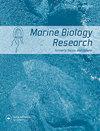Symbiodiniaceae in and ex hospite have differential physiological responses under different heat stress scenarios
IF 1.2
4区 生物学
Q4 ECOLOGY
引用次数: 0
Abstract
ABSTRACT Extreme seawater temperatures are linked to increasingly frequent cnidarian bleaching, a breakdown of the symbiosis between host and endosymbiotic dinoflagellates. This can be driven by several anthropogenic stressors, of which seawater warming is a major and frequent one. It remains unclear whether this is caused by intrinsic properties of the host or exclusively by the symbiont. This study investigates the response to elevated temperatures of dinoflagellate symbionts in and ex hospite, particularly to find out whether thermal tolerance differs between endosymbionts and free-living micro-algae. Maximum quantum yield of photosystem II (Fv/Fm ) and symbiont cell density were measured in seven different cnidarian species and five cultures of isolated endosymbionts subjected to temperatures of 26°C (control), 30°C and 34°C for 21 days. Isolated dinoflagellate cells showed a susceptibility to elevated temperatures of 30°C, evidenced by a decrease in photochemical efficiency and cell density of the cultures, as well as a progressive disintegration of cellular structures and loss of pigmentation of all but two cultures during the first week of exposure. Bleaching of coral holobionts at 30°C could be explained by reduced density of algae cells in host tissue. This effect was particularly evident in soft corals. Exposure to 34°C resulted in drastic bleaching of stony coral species, anemones and jellyfish, and even the death of soft corals. Data from this study show different responses to elevated thermal conditions across several species and different genera of symbionts and emphasize the important role of dinoflagellate symbionts in the holobiont response to elevated seawater temperatures.住院和出院的共生菌科在不同的热应激情景下有不同的生理反应
摘要极端的海水温度与越来越频繁的珊瑚白化有关,珊瑚白化破坏了宿主和内共生甲藻之间的共生关系。这可能是由几种人为压力源驱动的,其中海水变暖是一个主要且频繁的压力源。目前尚不清楚这是由宿主的固有特性引起的,还是完全由共生体引起的。这项研究调查了甲藻共生体在医院内外对高温的反应,特别是为了了解内共生体和自由生活微藻之间的耐热性是否不同。在26°C(对照)、30°C和34°C的温度下,在7种不同的线虫物种和5种分离的内共生体培养物中测量了光系统II的最大量子产率(Fv/Fm)和共生体细胞密度21天。分离的甲藻细胞表现出对30°C高温的易感性,培养物的光化学效率和细胞密度降低,以及在暴露的第一周内细胞结构的逐渐分解和除两种培养物外的所有培养物的色素沉着丧失都证明了这一点。珊瑚全生物在30°C下的漂白可以通过宿主组织中藻类细胞密度的降低来解释。这种影响在软珊瑚中尤为明显。暴露在34°C下会导致石珊瑚、海葵和水母急剧白化,甚至导致软珊瑚死亡。这项研究的数据显示,几种不同属的共生体对高温条件的反应不同,并强调了甲藻共生体在全生物对海水温度升高的反应中的重要作用。
本文章由计算机程序翻译,如有差异,请以英文原文为准。
求助全文
约1分钟内获得全文
求助全文
来源期刊

Marine Biology Research
生物-海洋与淡水生物学
CiteScore
2.10
自引率
0.00%
发文量
55
审稿时长
6-12 weeks
期刊介绍:
Marine Biology Research (MBRJ) provides a worldwide forum for key information, ideas and discussion on all areas of marine biology and biological oceanography. Founded in 2005 as a merger of two Scandinavian journals, Sarsia and Ophelia, MBRJ is based today at the Institute of Marine Research, Bergen, Norway. The Journal’s scope encompasses basic and applied research from all oceans and marine habitats and on all marine organisms, the main criterium for acceptance being quality.
 求助内容:
求助内容: 应助结果提醒方式:
应助结果提醒方式:


